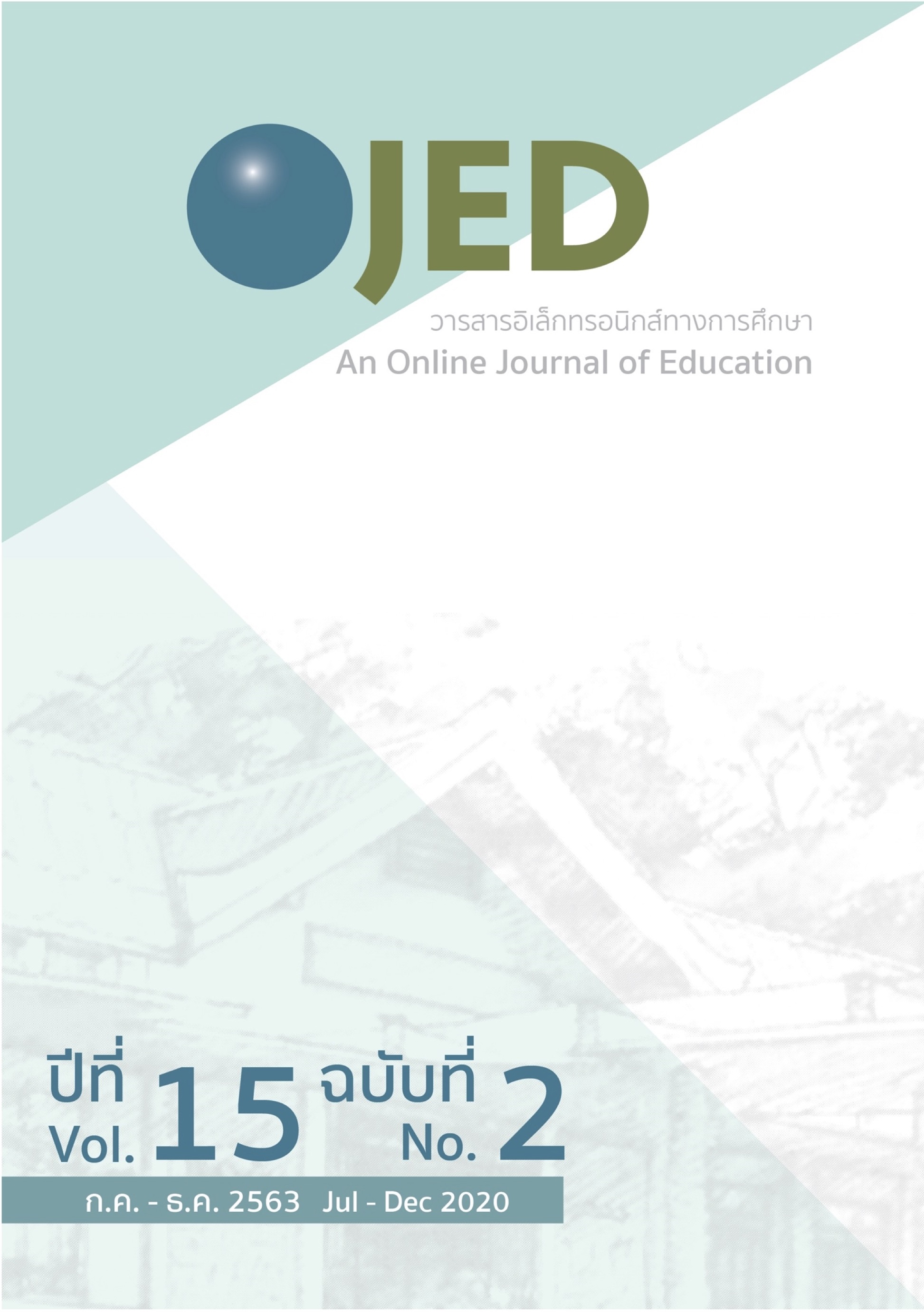Development of a Thinking-Based Learning Model with Social Networking Sites to Enhance Media Literacy of Undergraduate Students
DOI:
https://doi.org/10.14456/ojed.2020.38Keywords:
thinking-based learning, social networking sites, media literacyAbstract
The purpose of this research study was to design and develop a thinking-based learning model of social networking sites in order to enhance media literacy of undergraduate students. The samples for this survey consisted of seven experts and five advisors in the field of educational technology. The research instruments consisted of the expert interview form and the model evaluation form.
The result of this study is the model, consisting of five elements and eight steps. The five elements are: 1) Learning Objectives 2) Content Analysis 3) Social Networking Sites and Instructional Media 4) Thinking-Based Learning, and 5) Evaluation; the eight steps are: 1) Preparation of the Learning Management System 2) Questioning 3) Media Literacy Learning 4) Searching the Media 5) Analysis and Media Critique 6) Exchange of ideas and Discussion 7) Conclusion, and 8) Assessment and Evaluation. The evaluation showed the result to be at a high level. (M= 4.41, SD =0.53)
References
ชนาธิป นรกุล และ สุพิน บุญชูวงศ์. (2554). การสอนกระบวนการคิด : ทฤษฎีและการนำไปใช้. สำนักพิมพ์แห่งจุฬาลงกรณ์มหาวิทยาลัย.
ญาณากร สุทัสนมาลี และ สุเนตร สืบค้า. (2553). การสอนโดยการกระตุ้นให้นักศึกษาตั้งคำถาม (Teaching by motivating students to questioning) [รายงานการวิจัยในชั้นเรียน]. คณะวิศวกรรมและอุตสาหกรรมเกษตร มหาวิทยาลัยแม่โจ้. https://engineer.mju.ac.th/goverment/20111119104834_engineer/File20120629134256_14447.pdf
ทิศนา แขมมณี. (2550). ศาสตร์การสอน: องค์ความรู้เพื่อการจัดกระบวนการเรียนรู้ที่มีประสิทธิภาพ. สำนักพิมพ์แห่งจุฬาลงกรณ์มหาวิทยาลัย.
นิตยา ชูเอียด. (2551, 28 ตุลาคม). การสืบค้นข้อมูล. http://www.thaigoodview.com/library/teachershow/nakhonsithamrat/nittaya_c/meaow2/page04_2.htm
ปกรณ์ ประจัญบาน และ อนุชา กอนพ่วง. (2559). การวิจัยและพัฒนาแบบวัดทักษะในศตวรรษที่ 21 ด้านการรู้เท่าทันสื่อของนักเรียนชั้นมัธยมศึกษา. Journal of Education Naresuan University, 18(1), 144-154.
พรทิพย์ เย็นจะบก. (2552). ถอดรหัสลับความคิด เพื่อการรู้เท่าทันสื่อ: คู่มือการเรียนรู้เท่าทันสื่อ. ออฟเซ็ทครีเอชั่น.
วารีรัตน์ แก้วอุไร. (2555). การวางแผนการสอน. GotoKnow. https://www.gotoknow.org/posts/66247
สมศักดิ์ สินธุระเวชญ์. (2542). มุ่งสู่คุณภาพการศึกษา. ไทยวัฒนาพานิช.
สำนักงานคณะกรรมการกิจการกระจายเสียง กิจการโทรทัศน์ และกิจการโทรคมนาคมแห่งชาติ [กสทช]. (2556). สื่อมีบทบาทในสังคมอย่างไรบ้าง. http://bcp.nbtc.go.th/th/detail/2017-01-25-18-35-34.
สุกัญญา ศรีสืบสายม. (2551). การจัดการเรียนรู้ที่บูรณาการการอ่านและการคิด. นานมีบุ๊คส์พับลิเคชั่น.
อรวรรณ วงศ์แก้วโพธิ์ทอง. (2553). Social Media เครื่องมือเพิ่มศักยภาพทางธุรกิจ Social Media: Tool for Enhancing Business Competency. วารสารนักบริหาร, 30(4), 63-69.
อุษา บิ้กกิ้นส์. (2555). การรู้เท่าทันสื่อและสารสนเทศ Media and Information Literacy. วารสารสุทธิปริทัศน์, 26(80), 147-162.
Churchill, E. (2012, October). Social media meaning. In P. Cesar (Chair), SAM '12: Proceedings of the 2012 international workshop on Socially-aware multimedia. MM '12: ACM Multimedia Conference, Nara, Japan. http://dl.acm.org/citation.cfm?id=2390876
Eley, B., & Tilley, S. (2009). Online marketing inside out. SitePoint.
European Commission. (2007) Communication from the commission to the European parliament, the council, the European economic and social committee and the committee of the regions-A European approach to media literacy in the digital environment. Commission of the European Communities.
Swartz, R. J., Costa, A. L., Beyes, B. K., Reagan, R., & Kallick, B. (2008). Thinking-based learning: promoting quality student achievement in the 21th century. Columbia University.
Thoman, E., & Jolls, T. (2008). Literacy for the 21st century: An overview & orientation guide to media literacy education (2nd ed.). Center for Media Literacy.
Warr, W. A. (2008). Social software: Fun and games, or business tools. Journal of Information Science, 34(4), 591-604. https://doi.org/10.1177/0165551508092259
Wilson, C., Grizzle, A., Tuazon, R., Akyempong, K., & Cheung, C. (2011). Media and information literacy curriculum for teachers. UNESCO.
Downloads
Published
How to Cite
Issue
Section
License

This work is licensed under a Creative Commons Attribution-NonCommercial-NoDerivatives 4.0 International License.




